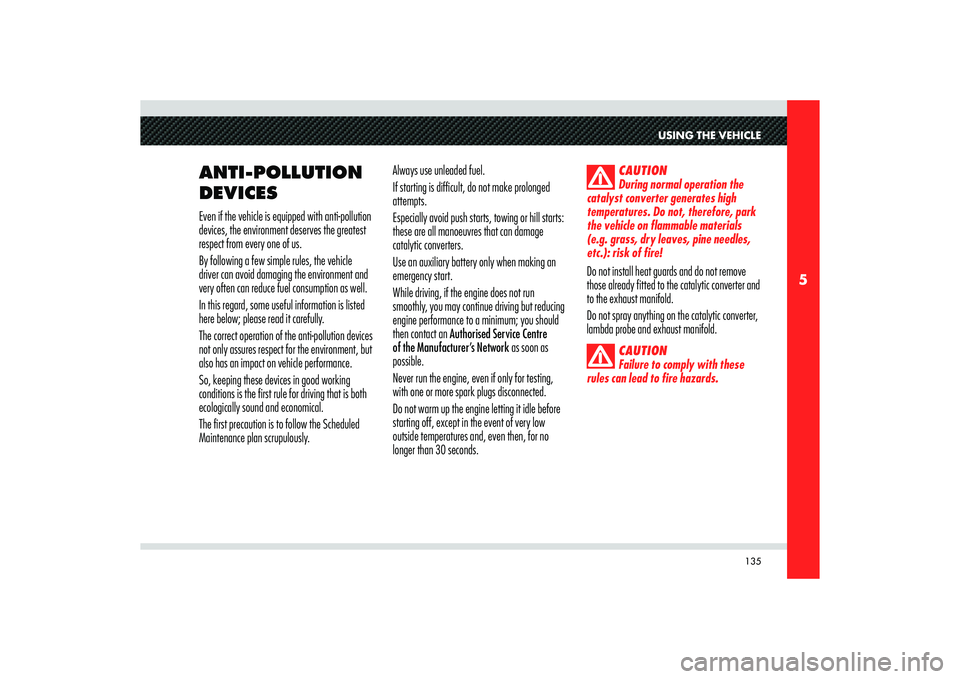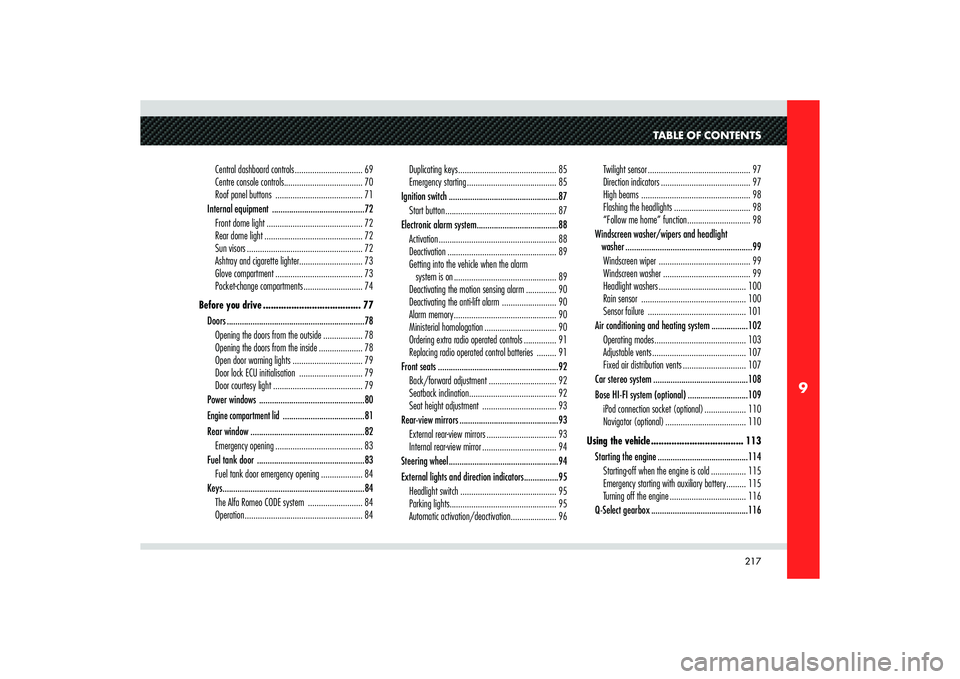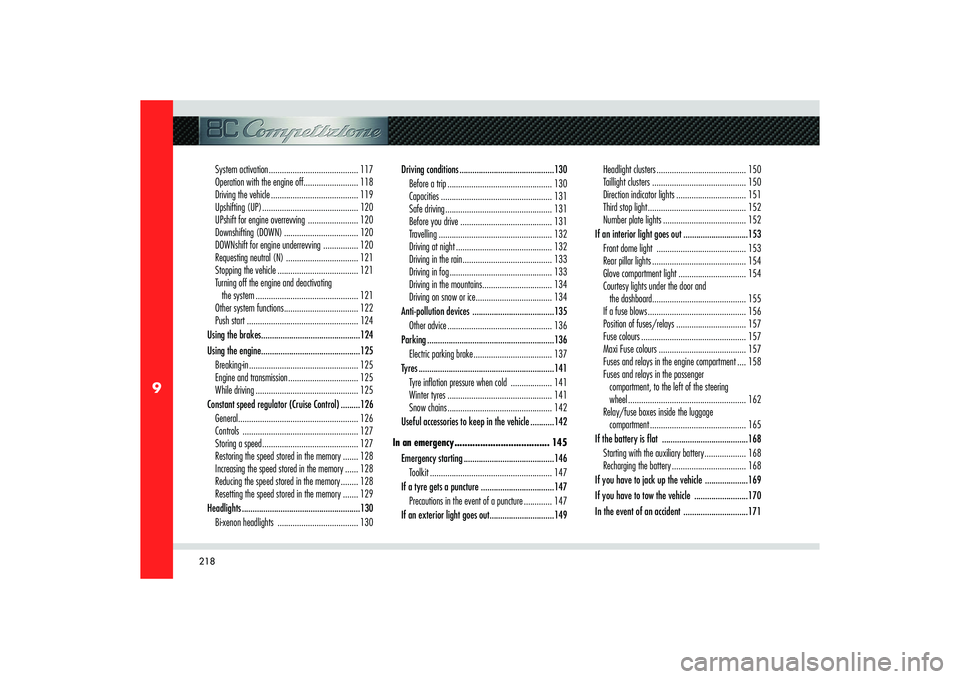AUX Alfa Romeo 8C 2009 Owner handbook (in English)
[x] Cancel search | Manufacturer: ALFA ROMEO, Model Year: 2009, Model line: 8C, Model: Alfa Romeo 8C 2009Pages: 223, PDF Size: 14.35 MB
Page 117 of 223

115
5
USING THE VEHICLE
STARTING-OFF WHEN
THE ENGINE IS COLD
Start-off slowly, avoiding sudden accelerations
and run the engine at low-medium speeds. High-
performance driving should be avoided until the
water temperature reaches
65–70 °C.EMERGENCY STARTING
WITH AUXILIARY
BATTERY
If the battery is flat, the engine can be started
using another battery having the same or slightly
higher capacity than the flat one.
Proceed as follows:
1) Connect the positive terminals (+) of the
two batteries with a cable specifi cally
designed for this purpose.
2) Connect the negative terminals (-) of the
two batteries with a cable specifi cally
designed for this purpose.
WARNING: The battery is housed in a metal box,
therefore, be extremely careful not to let the
battery charger clips come into contact with it.3) Start the engine.
4) When the engine starts, remove the cables
in reverse order.
If the engine does not start after a number
of attempts, do not continue indefinitely but
consult an Authorised Service Centre of the
Manufacturer’s Network.
CAUTION
Do not carry out this procedure
if you have no experience of it:
incorrect manoeuvres may cause high
levels of electrical discharge and may
even lead to the battery explosion.
CAUTION
You are also advised not to
approach the battery with open flames
or lit cigarettes and not to cause
sparks: risk of explosion and fire!
Page 137 of 223

135
5
USING THE VEHICLE
ANTI-POLLUTION
DEVICES Even if the vehicle is equipped with anti-pollution
devices, the environment deserves the greatest
respect from every one of us.
By following a few simple rules, the vehicle
driver can avoid damaging the environment and
very often can reduce fuel consumption as well.
In this regard, some useful information is listed
here below; please read it carefully.
The correct operation of the anti-pollution devices
not only assures respect for the environment, but
also has an impact on vehicle performance.
So, keeping these devices in good working
conditions is the first rule for driving that is both
ecologically sound and economical.
The first precaution is to follow the Scheduled
Maintenance plan scrupulously. Always use unleaded fuel.
If starting is difficult, do not make prolonged
attempts.
Especially avoid push starts, towing or hill starts:
these are all manoeuvres that can damage
catalytic converters.
Use an auxiliary battery only when making an
emergency start.
While driving, if the engine does not run
smoothly, you may continue driving but reducing
engine performance to a minimum; you should
then contact an Authorised Service Centre
of the Manufacturer’s Network as soon as
possible.
Never run the engine, even if only for testing,
with one or more spark plugs disconnected.
Do not warm up the engine letting it idle before
starting off, except in the event of very low
outside temperatures and, even then, for no
longer than 30 seconds.
CAUTION
During normal operation the
catalyst converter generates high
temperatures. Do not, therefore, park
the vehicle on flammable materials
(e.g. grass, dry leaves, pine needles,
etc.): risk of fire!
Do not install heat guards and do not remove
those already fitted to the catalytic converter and
to the exhaust manifold.
Do not spray anything on the catalytic converter,
lambda probe and exhaust manifold.
CAUTION
Failure to comply with these
rules can lead to fire hazards.
Page 170 of 223

168
6
B
C
A
IF THE BATTERY IS
FLAT First of all, we recommend that you read
the precautions contained in the section
”Maintenance“ to prevent the battery from
running flat and to help ensure its long life.
STARTING WITH THE
AUXILIARY BATTERY
See the chapter ”Starting the engine“ on page
114 in the section ”Using the vehicle”.WARNING: Under no circumstance should a
battery be used for an emergency start-up: This
could damage the electronic systems, particularly
the control units managing the ignition and fuel
supply functions.
RECHARGING THE
BATTERY
You are advised to recharge the battery slowly
and at a low amperage for about 24 hours.
Proceed as follows:
1) Deactivate the electronic alarm using the
radio control.
2) Lift the rear shelf
A and the box cover
B
and release the hooks
C.
WARNING: First disconnect the negative pole
terminal (–) then the positive pole one (+).3) Connect the battery charger cables to the
battery poles.WARNING: The battery is housed in a metal box, therefore, be extremely careful not to let the
battery charger clips come into contact with it.
4) Turn on the battery charger.
5) When the battery is recharged, turn off the
battery charger before disconnecting it from
the battery.
6) Reconnect the terminals to the battery
poles, observing the polarity.WARNING: First reconnect the positive pole
terminal (+) and then the negative pole one
(–).
WARNING: Before reconnecting the battery
terminals, check that the key has been removed
from the ignition or at least that it is in the STOP
position.
Page 201 of 223

199
8
MAINTENANCE
WARNING: If the battery charge remains
below 50% for a long period of time, it will be
damaged due to sulphating: this will reduce its
performance and starting power and the battery
will be more subject to freezing (this can happen
even at -10°C).We recommend that you have the battery charge
condition checked, preferably at the beginning of
the cold season, to prevent the electrolyte from
freezing.
This check should be performed more frequently
if the vehicle is used mainly for short trips or if it
is equipped with power absorbing devices that
remain permanently on even if when the ignition
key is removed. This applies above all if these
devices have been fitted “after market”.
If the vehicle is not used for long periods of time,
please refer to chapter “If the vehicle is laid up
for long periods”, in this section.WARNING: If additional systems have to be
fitted in the vehicle, there is the risk of creating
dangerous branches on the electric wiring, in
particular if the safety devices are involved.
ELECTRONIC
CONTROL UNITSNo special precautions are required for the
normal use of the vehicle.
In the event of repairs to the electrical system
or in an emergency starting, the following
instructions must be strictly followed:
- Never disconnect the battery from the
electrical system when the engine is
running.
- Disconnect the battery from the electrical
system when recharging it (see page 168
“If the battery is fl at”). WARNING: When the battery is disconnected,
you must first detach the negative pole terminal
(–) and then the positive pole one (+).
WARNING: The battery is secured inside the
vehicle by means of a metal box, therefore, be
extremely careful not to let the battery charger
clips come into contact with it.WARNING: When the battery is reconnected,
you must first attach the positive pole (+),
remembering to cover it with the cap provided,
and then the negative one (–).
- Never perform the emergency starting
procedure using a battery charger: always
use an auxiliary battery.
- Take special care when connecting the
battery to the electrical system, checking
both that polarity is correct and that the
connection is properly working.
- Do not connect or disconnect the terminals
of the ECUs when the ignition key is at
MAR.
- Do not check the electric polarities through
sparking.
- Disconnect the ECUs in the event of
electrical welding on the vehicle body.
Remove them if the temperature is
over 80°C (special interventions on the
bodywork, etc.).
Page 219 of 223

217
9
TABLE OF CONTENTS
Central dashboard controls ............................... 69
Centre console controls .................................... 70
Roof panel buttons ........................................ 71
Internal equipment ...........................................72
Front dome light ............................................ 72
Rear dome light ............................................. 72
Sun visors ..................................................... 72
Ashtray and cigarette lighter ............................. 73
Glove compartment ........................................ 73
Pocket-change compartments ........................... 74
Before you drive ...................................... 77
Doors ................................................................78
Opening the doors from the outside .................. 78
Opening the doors from the inside .................... 78
Open door warning lights ................................ 79
Door lock ECU initialisation ............................. 79
Door courtesy light ......................................... 79
Power windows .................................................80Engine compartment lid
......................................81
Rear window .....................................................82
Emergency opening ........................................ 83
Fuel tank door ..................................................83
Fuel tank door emergency opening ................... 84
Keys ..................................................................84
The Alfa Romeo CODE system ......................... 84
Operation ...................................................... 84Duplicating keys ............................................. 85
Emergency starting ......................................... 85
Ignition switch ...................................................87
Start button ................................................... 87
Electronic alarm system ......................................88
Activation ...................................................... 88
Deactivation .................................................. 89
Getting into the vehicle when the alarm
system is on ............................................... 89
Deactivating the motion sensing alarm .............. 90
Deactivating the anti-lift alarm ......................... 90
Alarm memory ............................................... 90
Ministerial homologation ................................. 90
Ordering extra radio operated controls ............... 91
Replacing radio operated control batteries ......... 91
Front seats ........................................................92
Back/forward adjustment ............................... 92
Seatback inclination ........................................ 92
Seat height adjustment .................................. 93
Rear-view mirrors ..............................................93
External rear-view mirrors ................................ 93
Internal rear-view mirror .................................. 94
Steering wheel ...................................................94
External lights and direction indicators ................95
Headlight switch ............................................ 95
Parking lights ................................................. 95
Automatic activation/deactivation ..................... 96Twilight sensor ............................................... 97
Direction indicators ......................................... 97
High beams .................................................. 98
Flashing the headlights ................................... 98
“Follow me home” function ............................. 98
Windscreen washer/wipers and headlight
washer ...........................................................99
Windscreen wiper .......................................... 99
Windscreen washer ........................................ 99
Headlight washers ........................................ 100
Rain sensor ................................................ 100
Sensor failure ............................................. 101
Air conditioning and heating system .................102
Operating modes .......................................... 103
Adjustable vents ........................................... 107
Fixed air distribution vents ............................. 107
Car stereo system ............................................108
Bose HI-FI system (optional) ............................109
iPod connection socket (optional) ................... 110
Navigator (optional) ..................................... 110
Using the vehicle .................................... 113
Starting the engine ..........................................114
Starting-off when the engine is cold ................ 115
Emergency starting with auxiliary battery ......... 115
Turning off the engine ................................... 116
Q-Select gearbox .............................................116
Page 220 of 223

218
9
System activation ......................................... 117
Operation with the engine off ......................... 118
Driving the vehicle ........................................ 119
Upshifting (UP) ............................................ 120
UPshift for engine overrevving ....................... 120
Downshifting (DOWN) .................................. 120
DOWNshift for engine underrevving ................ 120
Requesting neutral (N) ................................. 121
Stopping the vehicle ..................................... 121
Turning off the engine and deactivating
the system ............................................... 121
Other system functions .................................. 122
Push start ................................................... 124
Using the brakes ..............................................124
Using the engine ..............................................125
Breaking-in .................................................. 125
Engine and transmission ................................ 125
While driving ............................................... 125
Constant speed regulator (Cruise Control) .........126
General ....................................................... 126
Controls ..................................................... 127
Storing a speed ............................................ 127
Restoring the speed stored in the memory ....... 128
Increasing the speed stored in the memory ...... 128
Reducing the speed stored in the memory ........ 128
Resetting the speed stored in the memory ....... 129
Headlights .......................................................130
Bi-xenon headlights ..................................... 130Driving conditions ............................................130
Before a trip ................................................ 130
Capacities ................................................... 131
Safe driving ................................................. 131
Before you drive .......................................... 131
Travelling .................................................... 132
Driving at night ............................................ 132
Driving in the rain ......................................... 133
Driving in fog ............................................... 133
Driving in the mountains ................................ 134
Driving on snow or ice ................................... 134
Anti-pollution devices ......................................135
Other advice ................................................ 136
Parking ...........................................................136
Electric parking brake .................................... 137
Tyres ...............................................................141
Tyre infl ation pressure when cold ................... 141
Winter tyres ................................................ 141
Snow chains ................................................ 142
Useful accessories to keep in the vehicle ...........142
In an emergency ..................................... 145
Emergency starting ..........................................146
Toolkit ........................................................ 147
If a tyre gets a puncture ..................................147
Precautions in the event of a puncture ............. 147
If an exterior light goes out ..............................149Headlight clusters ......................................... 150
Taillight clusters ........................................... 150
Direction indicator lights ................................ 151
Third stop light ............................................. 152
Number plate lights ...................................... 152
If an interior light goes out ..............................153
Front dome light ......................................... 153
Rear pillar lights ........................................... 154
Glove compartment light ............................... 154
Courtesy lights under the door and
the dashboard ........................................... 155
If a fuse blows ............................................. 156
Position of fuses/relays ................................ 157
Fuse colours ................................................ 157
Maxi Fuse colours ........................................ 157
Fuses and relays in the engine compartment .... 158
Fuses and relays in the passenger
compartment, to the left of the steering
wheel ...................................................... 162
Relay/fuse boxes inside the luggage
compartment ............................................ 165
If the battery is � at ........................................168
Starting with the auxiliary battery ................... 168
Recharging the battery .................................. 168
If you have to jack up the vehicle ....................169
If you have to tow the vehicle .........................170
In the event of an accident ..............................171